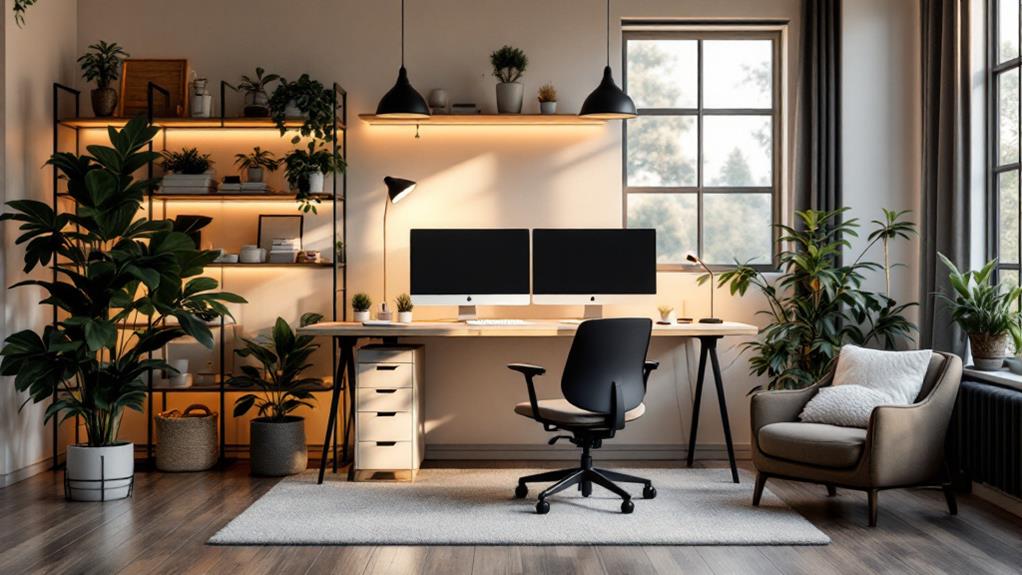To set up a home office, start by evaluating your work needs, such as essential tools and storage requirements, which influences your furniture choices. Choose a quiet space with ample natural light and adequate electrical outlets to boost productivity. Invest in ergonomic furniture like a chair that supports spine curvature and an adjustable desk to promote health. Incorporate adequate lighting with a mix of ambient and task options to avoid eye strain. Finally, organize with shelving and file cabinets, personalize your space with decor, and keep future upgrades in mind. As you explore further, you'll uncover more detailed suggestions.
Determine Your Needs
Setting up a home office begins with clarity about your specific needs. Start by evaluating the nature of your work. Do you require a computer, a printer, or specialized equipment? Understanding these needs helps you avoid unnecessary expenses and guarantees your workspace supports your tasks efficiently.
Consider the type of work you'll be doing—whether it's digital, paperwork-heavy, or involves creative activities—and list the essential tools for each.
Next, think about your work habits and preferences. Do you prefer working in a quiet environment, or does background noise help you concentrate? This insight guides your choices in office location and accessories like noise-canceling headphones or a sound system.
Evaluate how much time you'll spend in your office. If you're working full-time, investing in ergonomic furniture becomes more crucial to prevent discomfort and health issues.
Additionally, consider your storage requirements. Will you need filing cabinets, shelves, or digital storage solutions? Understanding your organizational needs guarantees that your office remains tidy and efficient.
Select the Right Space
Choosing the right space for your home office is vital for productivity and comfort. Start by evaluating the available areas in your home. Ideally, you should select a quiet, low-traffic location to minimize distractions.
Consider spaces like a spare bedroom, a corner of the living room, or even a converted attic or basement. The key is finding a spot where you can focus and separate work from home life.
Lighting is another important factor. Natural light is beneficial, as it reduces eye strain and improves mood. Position your desk near a window if possible, but make sure glare doesn't reflect on your computer screen.
If natural light isn't an option, invest in quality artificial lighting to keep your workspace well-lit.
Temperature control is also significant. Make sure the space has adequate heating and cooling for year-round comfort.
Evaluate the noise levels in the area; you might need soundproofing solutions if external noise is an issue.
Additionally, make sure there's sufficient electrical outlets and internet connectivity. A stable Wi-Fi connection and convenient access to power are vital for maintaining productivity.
Invest in Ergonomic Furniture
Once you've found the perfect spot for your home office, it's time to focus on the furniture that will support your productivity and well-being.
Investing in ergonomic furniture isn't just a trend; it's a necessity for maintaining comfort and preventing strain over long working hours.
Here's a breakdown of essential ergonomic furniture to contemplate:
- Ergonomic Chair: Choose a chair that supports the natural curve of your spine, with adjustable height and armrests. This helps reduce back pain and promotes good posture, allowing you to focus on tasks without discomfort.
- Adjustable Desk: An adjustable desk allows you to switch between sitting and standing, which can improve circulation and reduce fatigue. Look for a desk that provides enough surface area to accommodate your work essentials.
- Keyboard and Mouse: Ergonomic keyboards and mice are designed to minimize strain on your wrists and hands. Opt for models that keep your wrists in a neutral position, reducing the risk of repetitive strain injuries.
- Monitor Stand: Position your monitor at eye level to prevent neck strain. A monitor stand or a height-adjustable monitor arm can help achieve the ideal viewing angle.
Choose Appropriate Lighting
Lighting plays an essential role in creating a comfortable and productive home office environment. Proper lighting not only reduces eye strain but also enhances focus and mood.
To start, consider the placement of your desk near a window to take advantage of natural light. Natural light provides a full spectrum of light that can help regulate your circadian rhythm, promoting alertness during the day. However, be mindful of glare on your computer screen, which can be mitigated with curtains or blinds.
Supplement natural light with artificial lighting. A combination of ambient, task, and accent lighting can provide a balanced environment. Ambient lighting, like ceiling fixtures, gives overall illumination, while task lighting, such as desk lamps, focuses light on specific areas, reducing the need to strain your eyes while reading or working on detailed tasks. Accent lighting can be used to highlight art or plants, adding a personal touch.
When choosing light bulbs, opt for LED options with adjustable brightness and color temperature. A color temperature between 3000K and 5000K is ideal, as it mimics natural daylight. Adjustable settings allow you to tailor the lighting to suit different tasks or times of day, ensuring maximum comfort and efficiency.
Organize With Storage Solutions
Creating an organized home office is vital for maintaining productivity and reducing stress. Effective storage solutions help you keep your workspace tidy and efficient, allowing you to focus on tasks without constant clutter.
Start by evaluating your storage needs, considering the types of materials and equipment you use regularly. You'll want to incorporate different storage options to accommodate various items seamlessly.
- Shelving Units: Utilize vertical space by installing shelves. They're great for storing books, binders, and decorative items, freeing up desk space and keeping essential materials within reach.
- File Cabinets: Keep important documents organized with file cabinets. Use labeled folders to categorize files, making it easy to find what you need without sifting through piles of paper.
- Drawer Organizers: Tidy up desk drawers with organizers, which can hold supplies like pens, paperclips, and sticky notes. This prevents small items from becoming jumbled together, enhancing accessibility.
- Storage Boxes and Bins: Ideal for storing miscellaneous items, boxes and bins can be tucked under desks or placed on shelves. Labeling them guarantees you can quickly locate items as needed.
Set Up Technology Efficiently
A well-arranged tech setup is fundamental in transforming your home office into a productivity hub. Start by evaluating your needs and confirming your computer or laptop meets them.
Invest in a reliable, fast internet connection, as it's vital for seamless communication and research. Consider upgrading your router or using a mesh network to enhance connectivity, especially if your workspace is far from the main router.
Organize your cables using clips or ties to prevent tangling, which can lead to inefficiencies and hazards. A wireless keyboard and mouse can reduce clutter, providing a tidy workspace.
Verify your monitor is at eye level to maintain good posture and reduce strain. An external monitor might be beneficial if you work with multiple applications simultaneously.
Install essential software, like antivirus programs, to protect your data. Use cloud storage solutions such as Google Drive or Dropbox for easy access and file sharing. Regularly back up your data to prevent loss.
Consider using productivity tools like Trello or Asana to manage tasks efficiently. Finally, invest in a reliable printer and scanner if your work requires physical documents, confirming all tech components function harmoniously.
Personalize Your Workspace
Your workspace should reflect your personality and inspire creativity. When personalizing your home office, consider elements that make you feel comfortable and motivated. This is essential, as a well-designed workspace can enhance productivity and well-being.
Personal touches can transform a generic office setup into a space that genuinely feels like your own.
To begin personalizing, consider these four key elements:
- Color Scheme: Choose colors that resonate with you and evoke the mood you want. For example, blues and greens can be calming, while yellows and oranges might energize you.
- Artwork and Decor: Select art pieces or decor items that inspire or relax you. This could include family photos, motivational quotes, or abstract art.
- Furniture Arrangement: Arrange your furniture in a way that suits your workflow. Make sure your chair and desk are ergonomically placed to prevent strain.
- Organization Tools: Use organizational tools like shelves, baskets, or filing cabinets to keep your workspace tidy and efficient, making certain everything has its place.
Manage Cables and Wires
While setting up your home office, managing cables and wires is essential to maintaining a neat and efficient workspace. Start by identifying all the devices and their respective cords. Use cable ties or Velcro straps to bundle similar wires, reducing clutter. Labeling each cable helps you quickly identify connections, simplifying troubleshooting and adjustments later.
Consider using cable management sleeves or channels that adhere to your desk or walls, keeping wires tidy and out of sight. These tools not only organize cables but also prevent tangling and potential damage. Investing in a cable management box can also conceal power strips and excess cord lengths, minimizing visual distractions.
Position your desk near power outlets to avoid excessive extension cords, which can create hazards. If you need to extend the reach of your cables, opt for a high-quality surge protector to safeguard your devices against power surges. Additionally, wireless options, such as Bluetooth keyboards and mice, can reduce the number of cables you'll need to manage.
Regularly inspect your cable setup to verify everything remains orderly. Doing so helps maintain an efficient and professional-looking workspace, ensuring that your focus remains on work rather than unnecessary clutter.
Incorporate Plants and Decor
Enhancing your home office with plants and decor can transform it into a more inviting and stimulating environment. By incorporating elements of nature and design, you can improve productivity and morale.
Greenery not only boosts aesthetics but can also improve air quality and reduce stress. When selecting decor, focus on items that reflect your personality and professional goals.
Consider these steps when adding plants and decor:
- Choose Low-Maintenance Plants: Opt for plants like succulents or snake plants, which require minimal care and can thrive in various lighting conditions. These types of plants are ideal for busy schedules and can enhance visual appeal.
- Incorporate Functional Decor: Select decor that serves a dual purpose, such as bookshelves for organization or a stylish clock for time management. This approach maximizes efficiency and maintains a tidy appearance.
- Use Color Strategically: Colors can influence mood and productivity. Choose colors that promote focus and calm, such as blues and greens, to create a favorable working atmosphere.
- Personalize with Art and Photos: Display art that inspires you or photographs that evoke positive memories. These elements can personalize your space and provide visual breaks during work hours.
Incorporate these strategies to create a home office that balances functionality with aesthetics.
Plan for Future Upgrades
Thinking ahead about future upgrades can guarantee your home office remains functional and up to date.
Begin by evaluating your current setup and identifying areas where technology or furniture might soon become outdated. Consider investing in modular furniture, which allows for easy reconfiguration and expansion. This flexibility guarantees you can adapt your office to accommodate new equipment or work habits without a complete overhaul.
When it comes to technology, anticipate advancements in hardware and software. Opt for devices with upgradeable components, such as computers with extra RAM slots or storage expansion capabilities. This approach minimizes future costs and reduces the need for frequent replacements.
Staying informed about emerging trends and innovations keeps you ahead of the curve, guaranteeing your workspace remains competitive and efficient.
Additionally, allocate a portion of your budget for future upgrades. This financial foresight prevents unexpected expenses from derailing your plans.
Monitor warranties and service agreements, guaranteeing you're aware of what's covered and when renewals are necessary. By planning for future upgrades, you maintain a dynamic home office that evolves with your needs, supporting productivity and efficiency as your work requirements change over time.

